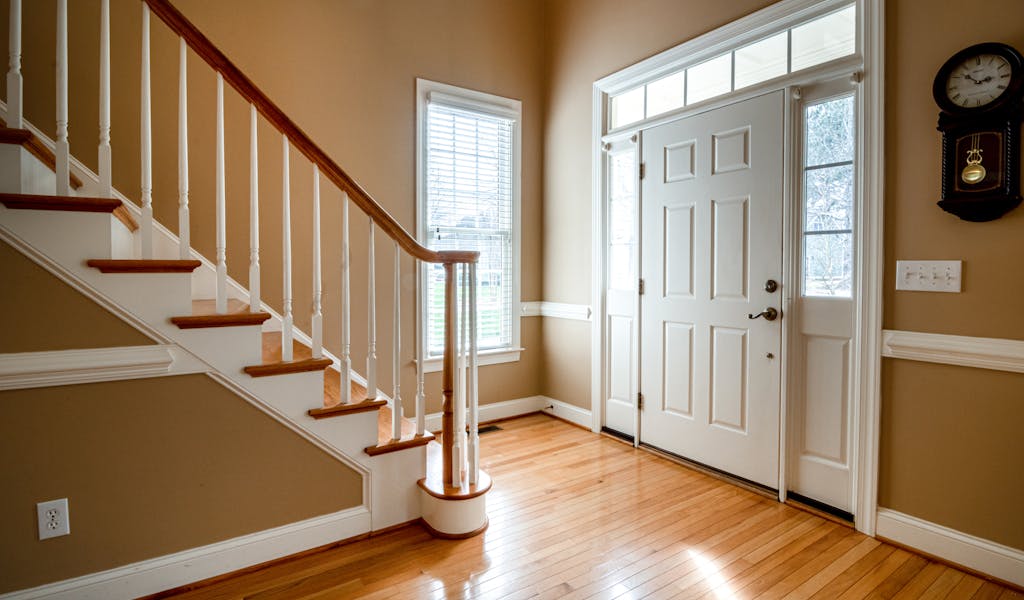Curtis Adams: https://www.pexels.com/photo/white-wooden-door-on-brown-wooden-parquet-floor-3935314/
Handrails provide crucial support and stability for individuals navigating staircases, especially those with mobility impairments or balance issues. They offer something to hold onto for support, reducing the risk of slips, trips, and falls. By improving safety, handrails help prevent accidents and injuries, promoting the well-being of all users.
Accessible stair handrails ensure that staircases are usable by everyone, regardless of their age or physical abilities. They enable individuals with mobility impairments, seniors, and those with temporary injuries to navigate stairs independently and safely.
This promotes inclusivity and ensures that buildings are accessible to a wider range of people, aligning with principles of universal design. Compliance with these standards is not only a legal obligation but also demonstrates a commitment to creating inclusive environments and accommodating the needs of all building users.
Part 1: Importance of Accessible Handrails
Accessible handrails are crucial to building design, providing support and guidance for individuals with mobility impairments. Ensuring their effectiveness involves attention to various key points:
● Height and Positioning
Accessible handrails must be positioned at an appropriate height to accommodate users of different heights and mobility devices. Consistency in height and positioning along stairways, ramps, and corridors is essential for users to rely on them confidently for support.
● Material and Texture
The material and texture of handrails significantly impact their usability for individuals with disabilities. Handrails should be made of materials that are sturdy and easy to grip, such as metal or durable plastic. Additionally, the surface texture should provide adequate friction to prevent slips, particularly when wet.
● Contrast and Visibility
Handrails should contrast visually with their surroundings to aid users with visual impairments in locating and identifying them easily. This can be achieved by using contrasting colors or materials between the handrail and adjacent surfaces. Illuminated handrails or the strategic placement of lighting fixtures can enhance visibility and safety for all users, including those with visual impairments.
Part 2: How to Choose the Right Handrails For Your Home?
To choose the right handrails for your home, consider factors such as:
1. Material
When selecting the right material for handrails in your home, factors such as durability, grip, and aesthetics are crucial considerations. Here’s a comparison of three common materials: wood, metal, and PVC:
● Wood
Wood handrails offer a warm, natural aesthetic that can complement various home decor styles. They provide a comfortable grip and can be customized with different finishes to enhance their durability and resistance to wear and tear. While wood handrails can provide adequate grip, the texture may vary depending on the type of wood and finish used.
● Metal
Metal handrails, typically made of stainless steel or aluminum, offer excellent durability and minimal maintenance requirements. They provide a sleek and modern aesthetic that can complement contemporary home designs. Metal handrails often feature a smooth surface that provides a secure grip, especially when combined with textured finishes or rubberized coatings.
● PVC
PVC (polyvinyl chloride) handrails are a cost-effective option that offers durability and low maintenance. They are resistant to moisture, rot, and insects, making them ideal for outdoor installations or high-humidity environments such as bathrooms. However, PVC handrails are available in various colors and can be customized to match your home’s aesthetic preferences.
2. Height and Placement
Proper height and placement of handrails are crucial for ensuring safety and accessibility on staircases. The recommended height for handrails is typically between 34 and 38 inches above the stair tread, as per accessibility standards such as the Americans with Disabilities Act (ADA). This range allows for comfortable and effective use by individuals of varying heights and mobility levels.
Having a VEVOR stair handrail on both sides offers greater stability and support, especially for individuals with mobility impairments or those carrying items while ascending or descending stairs. Ensuring consistent height and placement of handrails along the entire length of the staircase promotes uniformity and predictability for users, enhancing their confidence and safety.
3. Grip and Diameter
Achieving a comfortable and secure grip on handrails involves careful consideration of grip diameter and surface continuity. Here are some important points regarding grip diameter and surface continuity for handrails:
● Optimal Diameter
The diameter of handrails significantly impacts users’ comfort and stability while navigating staircases or ramps. A diameter ranging from 1 ¼ to 2 inches (approximately 3.2 to 5.1 centimeters) is generally recommended for achieving a comfortable grip. This diameter range accommodates various hand sizes and provides sufficient surface area for users to grasp firmly.
● Continuous, Uninterrupted Surface
Handrails should feature a continuous and uninterrupted surface along their entire length to ensure smooth and seamless navigation for users. Any breaks or interruptions in the handrail surface can pose hazards, particularly for individuals relying on them for support. This continuity is especially crucial at intersections, corners, or transitions between different sections of handrails to prevent users from losing their balance or encountering obstacles.
● Texture and Material Considerations
In addition to diameter and surface continuity, the texture and material of handrails play a vital role in enhancing grip and user comfort. The surface texture should provide adequate friction to prevent slips, especially when wet, while still allowing for a smooth and comfortable grip. Materials such as metal or durable plastic are commonly used for handrails due to their sturdiness and ease of maintenance.
4. Ends and Extensions
Rounded or returned ends, along with extensions beyond the top and bottom steps, serve important functions in ensuring the ease of use and safety of handrails:
● Preventing Snagging and Injury
Rounded or returned ends eliminate sharp edges that could catch on clothing or cause injury to users. By providing a smooth transition between the handrail and the adjacent surface, they reduce the risk of snagging or entanglement, particularly for individuals with mobility impairments or those using assistive devices.
● Enhancing Accessibility
Extensions beyond the top and bottom steps allow users to grasp the handrail before ascending or descending the stairs fully. This provides additional support and stability during transitions onto or off of the staircase, enhancing accessibility and promoting confidence for users with varying mobility levels.
● Guiding and Orienting Users
Extended handrail ends serve as visual and tactile cues, guiding users toward the beginning or end of the staircase. They help orient individuals, especially those with visual impairments, by indicating the presence of the handrail and facilitating smooth transitions between levels or spaces.
Part 3: VEVOR Stair Handrail: A Durable and Affordable Option
The VEVOR Stair Handrail stands out as a durable and affordable option for enhancing safety and accessibility in residential or commercial settings. Crafted from high-quality materials, this handrail ensures longevity and reliability, providing users with secure support while navigating staircases or ramps.
With its sturdy construction, the VEVOR Stair Handrail offers peace of mind, even in high-traffic areas or outdoor environments prone to harsh weather conditions. Its affordability makes it an attractive choice for budget-conscious individuals or businesses seeking to improve accessibility without compromising on quality.
Easy to install and maintain, the VEVOR Stair Handrail offers a cost-effective solution for enhancing the usability of staircases or ramps, making it an ideal choice for homeowners, contractors, or facility managers looking to meet accessibility requirements without breaking the bank.
Sum Up
Accessible VEVOR handrails provide users with a sense of comfort and confidence when using staircases. Knowing that support is readily available can alleviate anxiety and encourage individuals to navigate stairs more confidently, improving their overall experience within a building. This can contribute to a positive environment that prioritizes the well-being and independence of all occupants.

















